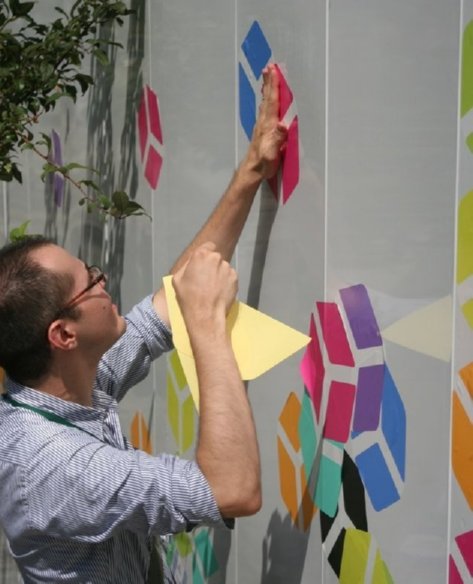Main content starts here.
Yokohama Triennale 2011
Last updated date:2025/12/9
Yokohama Triennale 2011
OUR MAGIC HOUR
How Much of the World Can We Know?
I arrived in Yokohama just over a month ago, and the first thing I did was... okay, it was to eat delicious food. But the second thing I did was to explore the city. As I walked around, I came upon strange statues, call them busts or faces, looking straight at me. And I looked back in astonishment, standing there, doing nothing for a whole hour: I was in another world. Okay, so it was probably closer to 2 minutes, but it felt like a long time!
Not knowing what was going on, I did some research, which in this case came down to walking in and asking the lady at the information desk! Although, had I just looked up at all the signs covering the city, I wouldn’t even have had to ask. Yokohama sure knows how to make sure you don’t miss its events!
Every three years, Yokohama holds an exhibition called the "Yokohama Triennale". This year, the title of this fourth installment is "Yokohama Triennale 2011, OUR MAGIC HOUR – How Much of the World Can We Know?" I guess my first impression—the daze it left me in—was right because the theme this year centers around the mysterious.
I was also pleasantly surprised to find out that the exhibition takes place in 2 different venues, to double the fun, as well as in a few other sites. Let’s call it exponential pleasuring of the senses! That being said, I’ll only introduce one of the main venues, that is, the Yokohama Museum of Art. As I walked in, I was greeted by a spiral of colorful disc-like objects titled “One Sentence”. But it is really after looking at it from the second floor that the scope of this installation from Beijing-based artist Yin Xiuzhen hits home and makes one realize how much even small variations in climate can affect the lives of people and society.
On the second floor, do not miss the three strategically placed telescopes. I won’t spoil it, but the artist Takahiro Iwasaki takes art (and in this case, Yokohama landmarks) to a new level. This use of space and distance was a very innovative concept to me. The media chosen also makes for an interesting experience.
Yoko Ono, she who needs no introduction, has created two pieces for Yokohama Triennale 2011. One can be seen from outside. It is a white sign that reads DREAM. Although in synch with the rest of the exhibition in essence, it is not quite as interesting to me as her second contribution: a telephone at the center of a glass maze! The concept is simple but effective: Ms. Ono is the only person with the number to this phone and she calls from time to time. Should you be the lucky, you may have a conversation with her.
Something that makes the Yokohama Museum of Art stand out, though, is that, being a museum, it has a permanent exhibition collection as well. Yokohama Triennale 2011 incorporated its installations to those already in place, making the visit a smorgasbord of comparison, opposition and collaboration between art and artists that might otherwise not have had much chance to mix.
In retrospect, some installations looked like stockrooms with stuff lying around; others were so elaborate they left no doubt as to their purpose. Some artists have pieces at more than one venue; others, more than one piece at a single venue. There were some collaborations that worked well together as well as some that were meant to contradict each other. But nothing felt forced or out of place.
Lastly, know that you are invited to contribute to art. The whole wall facing the museum’s main entrance, and Ugo Rondinone’s statues, is a concept by Carsten Nicolai. The German artist bought wooden boards to be used as canvas himself. Visitors are encouraged to get stickers from the visitor center and put them on the wall reserved for it. Don’t worry, it is a very big wall. Big enough for everyone to let their creativity run wild!

You can catch "Yokohama Triennale 2011, OUR MAGIC HOUR – How Much of the World Can We Know?" until Sunday, November 6, 2011. It is closed on most Thursdays, so check the schedule beforehand if you happen to want to visit on a Thursday.
There are also two different tickets for this event. The first one, priced ¥1600 allows entry to both main sites. You can exit and re-enter as many times as you want on the day of your visit, but be warned that it is not possible to come back to the first site visited after using the ticket for the second! I strongly recommend opting for the second type of ticket which is ¥1800. For only ¥200 more, it also allows you access to two of the secondary venues as well.
I also suggest getting a map for those who don’t want to miss anything. Otherwise, if time is not an issue, I recommend walking in a general direction (knowing where you’re heading, of course) and discovering the different sites like dropping in from one dream world to the next.
When: August 6th (Sat)~ November 6th (Sun), 2011
(Closed:August, September:Every Thursday / October:Every other Thursdays (13th, 27th))
Time: 11:00 - 18:00 (admission until 17:30)
Where: Yokohama Museum of Art, NYK Waterfront Warehouse (BankART Studio NYK) and the surrounding areas
Yokohama Triennale 2011 Official Site(外部サイト)(also in Chinese and Korean)
Note: Yokohama Triennale 2011 concluded in 2011.
Page ID:799-350-224

